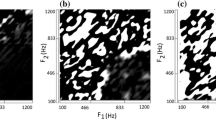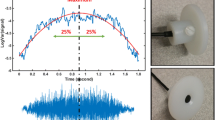Abstract
Sleep apnea is one of the most common sleep disorders. Here, patients suffer from multiple breathing pauses longer than 10 s during the night which are referred to as apneas. The standard method for the diagnosis of sleep apnea is the attended cardiorespiratory polysomnography (PSG). However, this method is expensive and the extensive recording equipment can have a significant impact on sleep quality falsifying the results. To overcome these problems, a comfortable and novel system for sleep monitoring based on the recording of tracheal sounds and movement data is developed. For apnea detection, a unique signal processing method utilizing both signals is introduced. Additionally, an algorithm for extracting the heart rate from body sounds is developed. For validation, ten subjects underwent a full-night PSG testing, using the developed sleep monitor in concurrence. Considering polysomnography as gold standard the developed instrumentation reached a sensitivity of 92.8% and a specificity of 99.7% for apnea detection. Heart rate measured with the proposed method was strongly correlated with heart rate derived from conventional ECG (r 2 = 0.8164). No significant signal losses are reported during the study. In conclusion, we demonstrate a novel approach to reliably and noninvasively detect both apneas and heart rate during sleep.







Similar content being viewed by others
References
Akselrod S, Gordon D, Ubel F, Shannon D, Berger A, Cohen R (1981) Power spectrum analysis of heart rate fluctuation: a quantitative probe of beat-to-beat cardiovascular control. Science 213:220–222. doi:10.1126/science.6166045
Alshaer H, Fernie GR, Maki E, Douglas Bradley T (2013) Validation of an automated algorithm for detecting apneas and hypopneas by acoustic analysis of breath sounds. Sleep Med 14:562–571. doi:10.1016/j.sleep.2012.12.015
Alshaer H, Fernie GR, Sejdic E, and Bradley TD (2009) Adaptive segmentation and normalization of breathing acoustic data of subjects with obstructive sleep apnea, 279–284. doi: 10.1109/TIC-STH.2009.5444489
Ben-Israel N, Tarasiuk A, Zigel Y (2012) Obstructive apnea hypopnea index estimation by analysis of nocturnal snoring signals in adults. Sleep. doi:10.5665/sleep.2092
Berg S, Haight JS, Yap V, Hoffstein V, Cole P (1997) Comparison of direct and indirect measurements of respiratory airflow: implications for hypopneas. Sleep 20:60–64
Boll S (1979) Suppression of acoustic noise in speech using spectral subtraction. IEEE Trans Acoust. Speech, Signal Process 27:113–120. doi:10.1109/TASSP.1979.1163209
Corral-Peñafiel J, Pepin J-L, Barbe F (2013) Ambulatory monitoring in the diagnosis and management of obstructive sleep apnoea syndrome. Eur Respir Rev: Off J Eur Respir Soc 22:312–324. doi:10.1183/09059180.00004213
Durán J, Esnaola S, Rubio R, Iztueta A (2001) Obstructive sleep apnea-hypopnea and related clinical features in a population-based sample of subjects aged 30 to 70 yr. Am J Respir Crit Care Med 163:685–689
Harper VP, Pasterkamp H, Kiyokawa H, Wodicka GR (2003) Modeling and measurement of flow effects on tracheal sounds. IEEE Trans Biomed Eng 50:1–10. doi:10.1109/TBME.2002.807327
Hossain I, and Moussavi Z (2002) “Respiratory airflow estimation by acoustical means,” in Second Joint EMBS-BMES Conference 2002 24th Annual International Conference of the Engineering in Medicine and Biology Society. Annual Fall Meeting of the Biomedical Engineering Society, 1476–1477
Iber C (2007) The AASM manual for the scoring of sleep and associated events: rules. Specification, Terminology and Technical
Kalkbrenner C, Eichenlaub M, Brucher R (2015) Development of a new homecare sleep monitor using body sounds and motion tracking. Curr Dir Biomed Eng 1. doi:10.1515/cdbme-2015-0008
Kalkbrenner, C., Stark, P., Kouemou, G., Algorri, M.-E., and Brucher, R. (2014). Sleep monitoring using body sounds and motion tracking. Conference proceedings: 36th Annual International Conference of the IEEE Engineering in Medicine and Biology Society. IEEE Engineering in Medicine and Biology Society. Annual Conference 2014, 6941–6944. doi: 10.1109/EMBC.2014.6945224
Karunajeewa AS, Abeyratne UR, Hukins C (2011) Multi-feature snore sound analysis in obstructive sleep apnea–hypopnea syndrome. Physiol Meas 32:83–97. doi:10.1088/0967-3334/32/1/006
Kemp B, Värri A, Rosa AC, Nielsen KD, Gade J (1992) A simple format for exchange of digitized polygraphic recordings. Electroencephalogr Clin Neurophysiol 82:391–393. doi:10.1016/0013-4694(92)90009-7
Kulkas A, Huupponen E, Virkkala J, Tenhunen M, Saastamoinen A, Rauhala E et al (2009) New tracheal sound feature for apnoea analysis. Med Biol Eng Comput 47:405–412. doi:10.1007/s11517-009-0446-z
Nakano H, Hayashi M, Ohshima E, Nishikata N, Shinohara T (2004) Validation of a new system of tracheal sound analysis for the diagnosis of sleep apnea-hypopnea syndrome. Sleep 27:951–957
Pasterkamp H, Kraman SS, Wodicka GR (1997) Respiratory sounds. Am J Respir Crit Care Med 156:974–987. doi:10.1164/ajrccm.156.3.9701115
Penzel T, Blau A, Garcia C, Schöbel C, Sebert M, Fietze I (2012) Portable monitoring in sleep apnea. Curr Respir Care Rep 1:139–145. doi:10.1007/s13665-012-0014-0
Peter, H., Penzel, T., and Peter, J. H. (2007). Enzyklopädie der Schlafmedizin. Berlin, Heidelberg: Springer Berlin Heidelberg
Romero Legarreta, I., Addison, P. S., Grubb, N., Clegg, G. R., Robertson, C. E., Fox, K., et al. “R-wave detection using continuous wavelet modulus maxima,” in Computers in Cardiology, 2003, 565–568
Sohrabi KA, Basu D, Schudt F, Scholtes M, Seifert O, Koehler U et al (2012) Quantification of nasal respiratory flow by tracheal sound analysis. Biomed Eng/ Biomedizinische Technik 57. doi:10.1515/bmt-2012-4227
Tenhunen M, Rauhala E, Huupponen E, Saastamoinen A, Kulkas A, Himanen S-L (2009) High frequency components of tracheal sound are emphasized during prolonged flow limitation. Physiol Meas 30:467–478. doi:10.1088/0967-3334/30/5/004
Yadollahi A, Azarbarzin A, Montazeri A, Moussavi Z (2012) Acoustical flow estimation in patients with obstructive sleep apnea during sleep. In: Conference proceedings: Annual International Conference of the IEEE Engineering in Medicine and Biology Society. IEEE Engineering in Medicine and Biology Society. Annual Conference 2012, pp 3640–3643. doi:10.1109/EMBC.2012.6346755
Yadollahi A, Giannouli E, Moussavi Z (2010) Sleep apnea monitoring and diagnosis based on pulse oximetry and tracheal sound signals. Med Biol Eng Comput 48:1087–1097. doi:10.1007/s11517-010-0674-2
Young T, Evans L, Finn L, Palta M (1997) Estimation of the clinically diagnosed proportion of sleep apnea syndrome in middle-aged men and women. Sleep 20:705–706
Acknowledgments
This study is part of the project entitled “SomnoSound” in cooperation with Beurer GmbH supported by the “Arbeitsgemeinschaft industrieller Forschungsvereinigungen AiF (KF2186205AK3)”. The authors would like to thank Beurer GmbH for their assistance and support.
Author information
Authors and Affiliations
Corresponding author
Ethics declarations
Conflict of interest
The authors state no conflict of interest. Informed consent has been obtained from all individuals included in this study. The research related to human use has been complied with all the relevant national regulations, institutional policies and in accordance the tenets of the Helsinki Declaration, and has been approved by the authors’ institutional review board or equivalent committee.
Rights and permissions
About this article
Cite this article
Kalkbrenner, C., Eichenlaub, M., Rüdiger, S. et al. Apnea and heart rate detection from tracheal body sounds for the diagnosis of sleep-related breathing disorders. Med Biol Eng Comput 56, 671–681 (2018). https://doi.org/10.1007/s11517-017-1706-y
Received:
Accepted:
Published:
Issue Date:
DOI: https://doi.org/10.1007/s11517-017-1706-y




